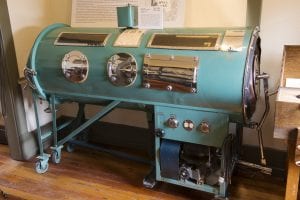As more and more people receive the COVID-19 vaccine, we can’t help but think of a particularly important artifact housed at the Pioneer Museum in Flagstaff, the iron lung. This early ventilator saved many lives when a previous epidemic spread across America. Polio left many children and adults paralyzed, some temporarily and some permanently. In the worst cases, the disease paralyzed the patient’s diaphragm causing death. In 1929 the first iron lung became available. The negative-pressure machine could keep a patient’s lungs pumping, giving them time to heal and grow stronger, much like the use of modern ventilators to treat COVID-19 today.
From 1929 until the 1950s, for patients who became severely paralyzed by polio, the iron lung was their best chance at survival. The poliomyelitis (polio) virus was first documented by a physician in 1789, but ancient art suggests the disease had been around for thousands of years. In 1952 Jonas Salk developed a vaccine to protect people from polio. When compared to that timeline, the progression of COVID-19 from an unknown novel virus to one preventable by a vaccine in less than a year is truly astounding! Historians will be talking about 2020 for a long time to come.
The iron lung is an imposing reminder of how technology and medicine have evolved throughout history to help people lead safer, healthier lives. In Pioneer Museum, the iron lung on display is from the 1950s and was used at Flagstaff Medical Center. This artifact challenges visitors to reflect on difficult history and to think about how Arizonans have dealt with disease outbreaks and pandemics of the past. Several years ago a visitor left this message on social media after visiting the museum:
“I was pregnant with my only child when I visited you and saw your iron lung. Propaganda for not vaccinating was all around me and I was seriously considering being an anti-vaxer. Standing in front of your exhibit was so powerful, I committed in that moment to offer my child every available vaccine. Thank you for your wonderful museum. In this way (plus the joy of attending your special events) you have made a huge difference for my family.”
You can learn more about the iron lung and the Pioneer Museum in this video created for the Flagstaff Festival of Science.
The Smithsonian recently launched a new website, “Vaccines & US” which offers information about COVID-19 science and vaccines, and provides tools and resources for families, educators, and organizations. Hear from Secretary Lonnie Bunch about how he received the polio vaccine as a child, and how today the Smithsonian now holds the first vial of the COVID-19 vaccine in its collections. You can examine past global health emergencies and learn more about vaccinations in American history. Visit https://www.si.edu/vaccinesandus/covid-19-and-history to learn more.
For information about COVID-19 vaccines in Arizona, please visit the Arizona Department of Health Services website at https://www.azdhs.gov/.
Sacha Siskonen
Museum Educator
Email Sacha
At the time of this blog post, Pioneer Museum is temporarily closed. The grounds are open Tuesday – Saturday, 10 a.m. to 5:00 p.m. Stay tuned for reopening news.




